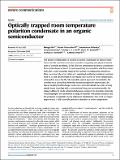Optically trapped room temperature polariton condensate in an organic semiconductor
Date
23/11/2022Author
Grant ID
EP/M025330/1
EP/S014403/1
EP/L015110/1
N/A
Metadata
Show full item recordAbstract
The strong nonlinearities of exciton-polariton condensates in lattices make them suitable candidates for neuromorphic computing and physical simulations of complex problems. So far, all room temperature polariton condensate lattices have been achieved by nanoimprinting microcavities, which by nature lacks the crucial tunability required for realistic reconfigurable simulators. Here, we report the observation of a quantised oscillating nonlinear quantum fluid in 1D and 2D potentials in an organic microcavity at room temperature, achieved by an on-the-fly fully tuneable optical approach. Remarkably, the condensate is delocalised from the excitation region by macroscopic distances, leading both to longer coherence and a threshold one order of magnitude lower than that with a conventional Gaussian excitation profile. We observe different mode selection behaviour compared to inorganic materials, which highlights the anomalous scaling of blueshift with pump intensity and the presence of sizeable energy-relaxation mechanisms. Our work is a major step towards a fully tuneable polariton simulator at room temperature.
Citation
Wei , M , Verstraelen , W , Orfanakis , K , Ruseckas , A , Liew , T C H , Samuel , I D W , Turnbull , G & Ohadi , H 2022 , ' Optically trapped room temperature polariton condensate in an organic semiconductor ' , Nature Communications , vol. 13 , no. 1 , 7191 . https://doi.org/10.1038/s41467-022-34440-0
Publication
Nature Communications
Status
Peer reviewed
ISSN
2041-1723Type
Journal article
Description
M.W., G.A.T., and I.D.W.S. acknowledge financial support from the Engineering and Physical Sciences Research Council (EPSRC) programme grant Hybrid Polaritonics (EP/M025330/1), and from the Scottish Funding Council. W.V. and T.L. were supported by the Ministry of Education (Singapore) Tier 2 grant MOE2019-T2-004. H.O. acknowledges EPSRC through a grant (EP/S014403/1). K.O. acknowledges EPSRC for PhD studentship support through a grant (EP/L015110/1).Collections
Items in the St Andrews Research Repository are protected by copyright, with all rights reserved, unless otherwise indicated.

